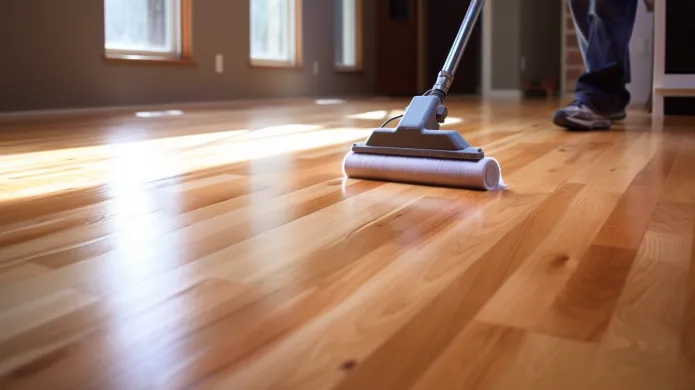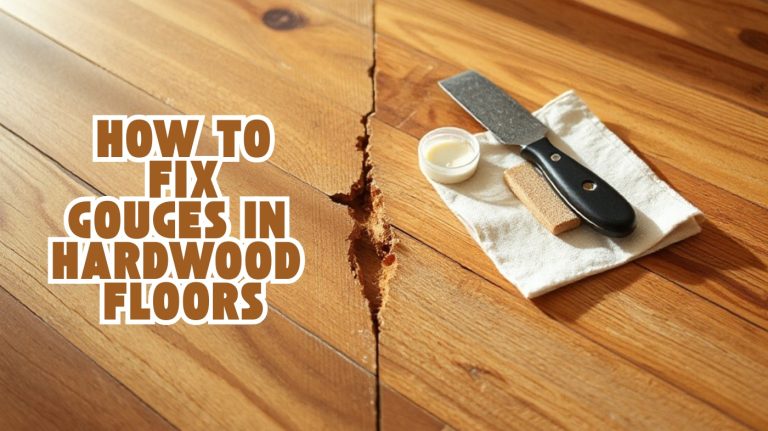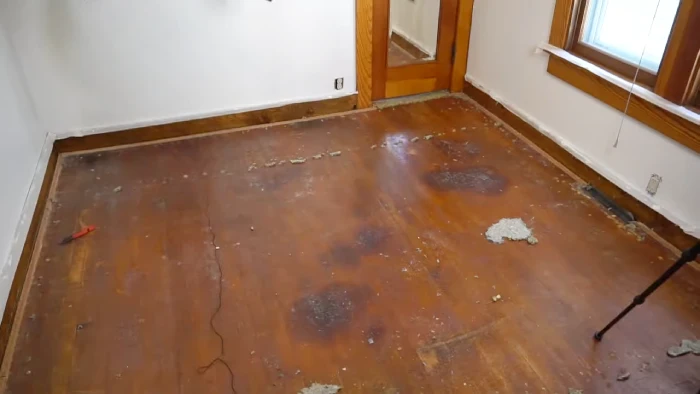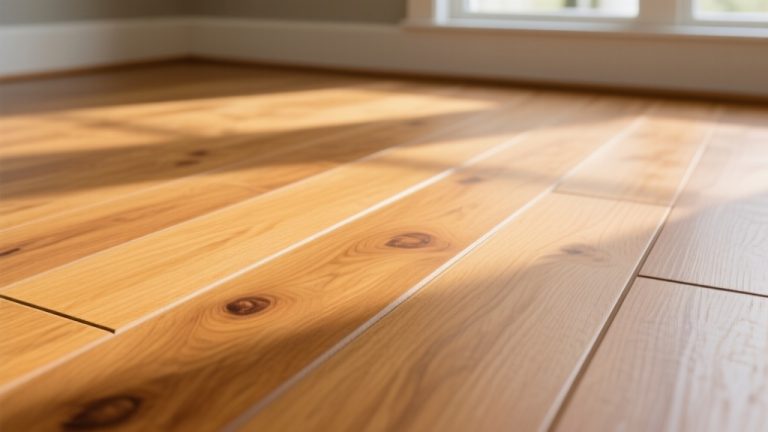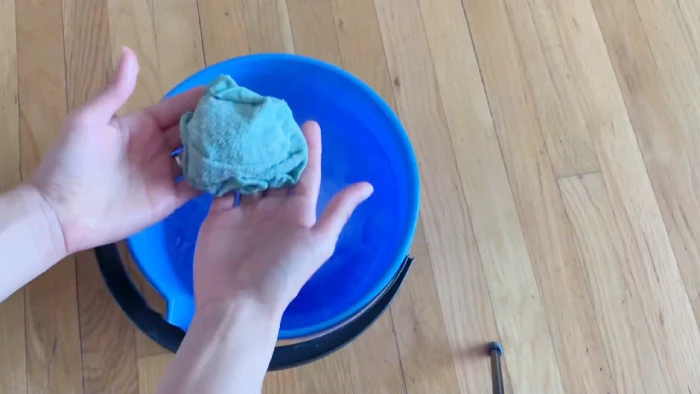Carbonised bamboo is bamboo treated with controlled heating between 100°C and 220°C to alter its chemical and physical structure. This process caramelizes natural sugars, producing a durable, darkened material with improved moisture resistance, hardness, and pest resistance.
You’ll notice reduced density, increased brittleness at higher temperatures, and enhanced aesthetic appeal with uniform dark tones. The thermal treatment also boosts bamboo’s environmental sustainability by preserving its renewable qualities.
Explore further to understand how temperature and treatment affect its performance and applications.
Key Takeaways
- Carbonised bamboo is bamboo thermally treated between 100°C and 220°C under low oxygen to darken color and enhance durability.
- The process caramelizes natural sugars throughout the bamboo, producing a warm, uniform dark brown hue without dyes or stains.
- Carbonisation reduces moisture content, increases hydrophobicity, and improves pest resistance and dimensional stability.
- It causes physical changes like decreased density, increased hardness, and slight brittleness, affecting mechanical properties.
- Carbonised bamboo is eco-friendly, renewable, and widely used in flooring, furniture, and decorative applications for its durability and aesthetics.
Definition and Carbonization Process
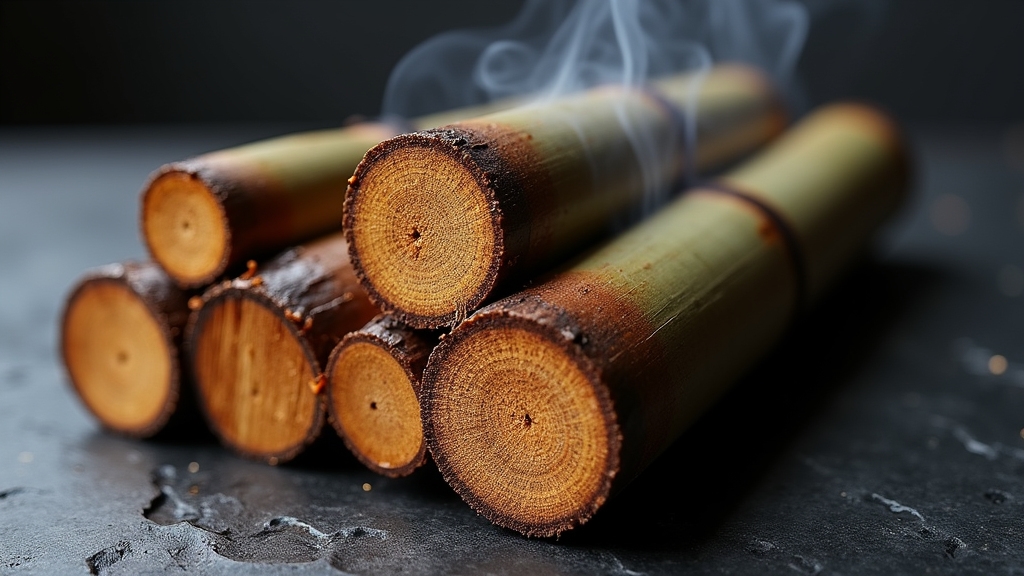
Although bamboo naturally exhibits a light color, carbonising it through controlled heating alters its chemical composition, resulting in a uniform, darker hue that ranges from golden to deep brown.
This carbonization, or caramelization, targets the natural sugars within the bamboo, transforming its color throughout the material rather than merely on the surface.
You start by selecting mature culms, generally 3 to 5 years old, then cut them into strips. These strips undergo steam treatment or kiln heating at 100°C to 150°C for several hours, depending on the desired shade.
After heating, you dry the bamboo to stabilize moisture content, preparing it for further processing. Proper moisture control is essential to ensure durability and prevent warping in the final product.
This method enhances the aesthetic appeal, creating a consistent, luxurious appearance without using stains or dyes. Because bamboo is a rapidly renewable resource, this carbonization process supports sustainable material use.
Physical Changes in Bamboo After Carbonization
When bamboo undergoes carbonization, one of the first things you’ll notice is a significant change in color. It transitions from a light yellow to a deep brown, which really highlights the chemical changes taking place. Visual observations noted the occurrence of cracks and splits as indicators of structural and chemical modifications during carbonization.
As the temperature goes up, you’ll also see a considerable drop in both density and weight. This happens because the hemicellulose and cellulose components are breaking down through thermal decomposition. These changes affect the material’s mechanical properties and durability.
At the same time, there’s an interesting twist: bamboo actually becomes harder, but it also starts to become more brittle. This shift really alters how the bamboo behaves mechanically and changes its surface characteristics.
Color Transformation
When bamboo undergoes carbonization, heating it between 200°C and 320°C in a low-oxygen environment triggers thermal decomposition of its organic compounds, leading to a distinct physical color transformation.
This controlled process is similar in principle to how thermal stability is managed during hardwood floor preparation to ensure material durability. This change results primarily from caramelization of sugars within the bamboo fibers, not from chemical dyes.
The absence of oxygen prevents combustion, enabling controlled darkening. You’ll observe a shift from bamboo’s natural pale blond to hues ranging from light amber through rich caramel to deep coffee brown.
The depth of color depends on heat exposure duration, temperature, and bamboo age.
Carbonization darkens the surface uniformly, accentuating the grain pattern. This color penetrates the fibers, so scratches won’t reveal lighter material beneath.
The result is a warm, elegant appearance achieved through a safe, chemical-free, eco-friendly process. This carbonization process also enhances the material’s durability and aesthetic appeal.
Density and Weight Reduction
Carbonization not only alters bamboo’s color but also substantially impacts its physical properties, notably density and weight.
As you increase the carbonization temperature from 200°C to 600°C, bamboo’s density decreases markedly from approximately 0.56–0.71 g/cm³ down to 0.32–0.49 g/cm³ due to the breakdown of organic compounds and volatile matter loss.
This density change influences the material’s durability and resistance, similar to how wear layer thickness affects engineered hardwood performance. At 800°C, density slightly rises again, likely from structural rearrangements.
Weight loss corresponds directly with temperature; higher temperatures cause more mass reduction, reaching char yields over 30% in dense species.
Volume reduction is pronounced, exceeding wood’s shrinkage, and intensifies with temperature.
For practical purposes, understanding these changes helps you optimize carbonization parameters to balance material weight, density, and resulting char yield. This is critical for both product performance and economic efficiency in bamboo charcoal production.
Moreover, the weight reduction rate increases significantly from 15–25% at 200 °C to 64–75% at 1000 °C, largely due to water evaporation initially and lignin decomposition at higher temperatures, demonstrating the importance of temperature management in the carbonization process weight reduction rate.
Hardness and Brittleness
Although heat treatment considerably enhances bamboo’s hardness by transforming its lignin and decomposing hemicellulose, it also increases brittleness due to moisture loss and cellulose degradation. This process is somewhat analogous to how organic mulches decompose and alter physical properties over time in landscaping applications, affecting durability and maintenance.
You’ll notice hardness peaks at moderate carbonization temperatures (400–600°C), where removal of hemicellulose and partial cellulose breakdown densify the structure, making bamboo comparable to hardwoods in hardness.
However, as you exceed 600°C, brittleness rises sharply because cellulose and hemicellulose degradation weaken flexibility, causing increased susceptibility to cracking and chipping under stress. This brittleness can limit applications requiring impact resistance.
The balance between hardness and brittleness depends on species, age, and carbonization duration. Studies on various Malaysian bamboo species have shown that basic density increases with culm height, which influences mechanical properties after carbonization.
Understanding these factors helps you optimize carbonization parameters to achieve desirable mechanical properties without compromising structural integrity.
Chemical Transformations During Carbonization
When you look closely at carbonization, you’ll notice that it breaks down hemicellulose and cellulose at different temperature ranges. This really changes their chemical structures and also helps to reduce moisture content.
Proper temperature control is essential to avoid damaging the wood’s finish during this process, similar to recommendations for cleaning hardwood floors with non-abrasive methods.
It’s pretty interesting how this process also raises the pH levels because of the increase in alkaline minerals. This change actually boosts bamboo’s ability to fight off pests and resist microbial degradation.
During carbonization, significant weight loss occurs up to 600 °C, leaving a stable carbon residue that forms the basis for activated carbon with enhanced porosity and surface area thermal decomposition.
Organic Compound Breakdown
How do the organic compounds in bamboo transform under intense heat without combustion? When you heat bamboo between 300 °C and 900 °C in an oxygen-limited environment, you initiate pyrolysis, which involves dehydration, devolatilization, and char formation. This process is somewhat analogous to how hardwoods develop increased hardness and density through chemical transformations and moisture loss.
Hemicellulose breaks down first, releasing volatile organic compounds mainly between 200–320 °C. As temperature rises, cellulose progresses from crystalline to amorphous, undergoing significant depolymerization. Studies indicate that higher temperatures lead to morphological transformations such as increased porosity and structural changes.
Lignin degrades slowly over a broad range, contributing aromatic structures to the carbon matrix that enhance stability. Thermal cleavage of C–O and C–C bonds triggers chain scission and molecular rearrangement, reducing oxygen and hydrogen content and increasing carbon concentration.
This complex breakdown yields a porous carbon matrix with altered mechanical and chemical properties essential to carbonised bamboo’s durability and adsorption capacity. Similar to how hardwoods’ mechanical properties are influenced by their chemical composition and moisture content, carbonised bamboo’s characteristics depend on these transformations.
pH and Cellulose Changes
When bamboo undergoes carbonization, the pH and cellulose structure transform considerably due to thermal decomposition and chemical reactions. Initially acidic, bamboo’s pH shifts to neutral around 280 °C and becomes alkaline at higher temperatures as organic acids decompose and alkaline ash forms.
Proper moisture control is essential during these processes to prevent structural damage, similar to how moisture control is critical in hardwood floor maintenance.
Simultaneously, crystalline cellulose breaks down into an amorphous form, increasing porosity and altering mechanical properties. These changes enhance carbon content and surface hydrophobicity.
Heat treatment studies show that degradation of hemicelluloses and other carbohydrates leads to decreased free hydroxyl groups, resulting in increased water repellency and changes in surface chemistry (chemical component degradation).
| Temperature (°C) | Chemical Effect |
|---|---|
| 200-240 | Hemicellulose degrades; pH approaches neutral |
| 280 | pH reaches neutral |
| 320 | Cellulose crystallinity lost; amorphous structure forms |
| >700 | pH becomes alkaline; ash content increases |
These transformations critically influence bamboo’s adsorption and surface chemistry. Consistent maintenance and careful treatment practices, such as those used in caring for Swedish finish hardwood floors, help preserve the material’s integrity during and after carbonization.
Moisture and Pest Resistance
Although bamboo’s natural composition makes it prone to moisture absorption and pest infestation, carbonization considerably alters its chemical structure to enhance resistance.
Thermal treatment breaks down hydrophilic components, reducing water absorption by over 50%, tightening fiber structure, and improving dimensional stability. This limits swelling, warping, and microbial growth, especially in humid environments.
The process involves heating bamboo at high temperatures in a low-oxygen environment, which causes thermal decomposition of organic compounds within bamboo, leading to these beneficial changes in material properties (Principle of Carbonization).
Proper ventilation during processing also helps minimize potential emissions of volatile organic compounds. Simultaneously, organic nutrients like sugars and proteins degrade under high heat and pressure, decreasing susceptibility to termites, fungi, and bacteria without chemical pesticides.
Carbonization forms a stable, carbon-rich matrix with increased surface hardness and reduced biodegradable material, enhancing rot and decay resistance.
These chemical transformations create a moisture-resistant, pest-repellent bamboo ideal for sustainable construction, combining improved durability with eco-friendly processing.
Common Applications of Carbonised Bamboo
Why has carbonised bamboo become a preferred material across diverse industries? Its enhanced strength, durability, and rich aesthetic make it ideal for multiple applications. You’ll find it in residential and commercial flooring, wall paneling, furniture, decorative elements, and structural components.
Additionally, carbonisation involves pressure steaming which darkens the bamboo and slightly decreases its hardness, balancing beauty with practical hardness properties. This process also contributes to improved moisture resistance, which is crucial for longevity in various environments.
Its sustainability and resistance to moisture and pests add functional value.
| Application | Benefit | Emotion Evoked |
|---|---|---|
| Flooring & Paneling | Strength, elegance | Confidence, warmth |
| Furniture | Durability, visual appeal | Comfort, pride |
| Construction | Load-bearing, eco-friendly | Security, responsibility |
Leveraging carbonised bamboo lets you combine sustainability with performance. This elevates design and structural integrity simultaneously.
Durability and Maintenance Tips
Since carbonised bamboo undergoes a high-temperature carbonisation process, it offers a balance between enhanced aesthetic appeal and durable performance. This makes it suitable for demanding environments. The carbonisation process significantly influences durability, moisture, and pest resistance, creating a unique material with enhanced functional qualities.
Strand woven carbonised bamboo flooring has hardness exceeding oak and tensile strength surpassing steel. It effectively resists dents, scratches, and heavy traffic.
Although about one-third softer than natural bamboo, it remains more wear-resistant than many conventional materials. Its moisture and pest resistance result from the removal of sugars and proteins during carbonisation, reducing rot and insect risks.
To maintain durability, sweep regularly and damp mop with mild cleaners. Avoid excessive water or harsh chemicals. Promptly wipe spills and use felt pads to prevent surface damage.
Refinishing every few years preserves appearance and extends service life remarkably. This process also supports sustainable development by utilizing renewable bamboo resources.
Environmental Impact and Sustainability
Beyond its durability and maintenance advantages, carbonised bamboo plays a significant role in environmental sustainability. Bamboo absorbs up to 17 metric tons of CO₂ per hectare annually, outperforming equivalent tree populations.
Bamboo captures up to 17 metric tons of CO₂ per hectare each year, exceeding tree absorption rates.
Its rapid growth, up to 35 inches daily, enables frequent harvests and continuous carbon sequestration, making it a potent carbon sink.
You’ll find bamboo cultivation requires minimal land, water, and no synthetic chemicals, reducing environmental pollution. This characteristic allows bamboo to thrive in diverse ecological conditions, supporting reforestation efforts through its versatile growth.
Its root system regenerates without replanting, preserving soil structure and preventing erosion. Although carbonising bamboo involves extra energy input, sustainable management keeps its lifecycle carbon footprint low.
By substituting energy-intensive materials like plastics and concrete, carbonised bamboo further reduces greenhouse gas emissions. Integrating bamboo enhances biodiversity and ecosystem resilience, confirming its value as an eco-efficient, renewable resource.
Industry Practices and Temperature Effects
Although carbonised bamboo production involves several meticulous steps, industry practices have optimized the process to guarantee consistent quality and performance.
You start with mature bamboo culms aged 3-5 years, then strip, clean, and prepare fibers before carbonization. Controlled heating between 100°C and 220°C under low-oxygen conditions induces chemical and mechanical changes, enhancing durability and aesthetics while reducing pests.
| Temperature (°C) | Color Change | Fiber Effect |
|---|---|---|
| 100-140 | Light brown | Initial fiber tightening |
| 140-180 | Medium brown | Increased dimensional stability |
| 180-220 | Dark chocolate brown | Maximum fiber restructuring |
| >220 | Charring risk | Structural degradation |
| Ideal Range | 140-220 | Enhanced durability and resistance |
This precise thermal control balances enhanced mechanical properties with minimal hardness loss.
Frequently Asked Questions
How Does Carbonised Bamboo Compare in Cost to Traditional Hardwood?
You’ll find carbonised bamboo flooring generally costs between $7 and $20 per square foot, which is comparable to traditional hardwood. Typically, hardwood flooring ranges from $5 to $15 per square foot for standard species.
While bamboo’s rapid renewability lowers raw material costs, the carbonisation process can add slight premiums. Installation costs for both are similar, so overall, you shouldn’t expect significant price differences.
However, exotic hardwoods often cost more than carbonised bamboo.
Can Carbonised Bamboo Be Used Outdoors Without Sealing?
You can use carbonised bamboo outdoors without sealing, but don’t expect it to stay pristine.
Its thermal treatment boosts moisture resistance and durability, yet it remains hygroscopic and vulnerable to UV damage and weathering.
Without sealing, you risk faster surface checking, color fading, and potential warping.
Is Carbonised Bamboo Safe for Pets and Children?
Yes, carbonised bamboo is safe for pets and children. It’s non-toxic, hypoallergenic, and certified to meet strict indoor air quality standards, so you won’t worry about harmful emissions.
Its low VOC levels reduce respiratory risks, and its smooth finish minimizes injury risks.
Plus, it resists mold and dust mites, benefiting allergy-prone individuals.
Regular cleaning with mild methods keeps it safe, making it a smart, durable choice for family homes.
How Long Does Carbonised Bamboo Flooring Typically Last?
You can expect carbonised bamboo flooring to last around 15 to 25 years with proper installation, maintenance, and moderate use.
Its lifespan is shorter than strand-woven bamboo due to the softening effect of carbonisation, making it more prone to dents and scratches.
Environmental factors like humidity and high foot traffic also impact durability.
However, regular cleaning, prompt repairs, protective measures, and refinishing can effectively extend its service life within that range.
Are There Any Health Risks Associated With Carbonised Bamboo Products?
You might think carbonised bamboo products are completely safe, but they can pose health risks.
During manufacturing, toxic chemicals like carbon disulfide and formaldehyde may be present, potentially causing respiratory issues, endocrine disruption, or organ damage.
Inadequate ventilation releases harmful gases, and residues can linger in fabrics or food-contact items.
Always check product certifications to minimize exposure to these toxic substances and reduce health risks from carbonised bamboo goods.
Carbonised Bamboo: The Quiet Revolution in Sustainable Design
Now that you understand carbonised bamboo’s transformation, from its physical and chemical shifts to its sustainable advantages, you’re better equipped to appreciate its potential. While it’s not just bamboo with a tan, its enhanced durability and eco-friendly profile make it a smart choice in various industries.
Keep in mind, subtle temperature tweaks during carbonization can considerably impact quality. Embrace carbonised bamboo as a refined, resilient material that’s quietly shaping greener futures.

